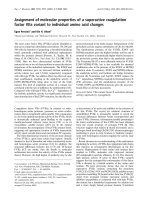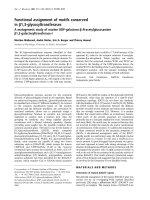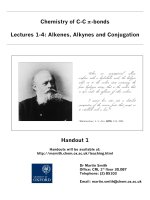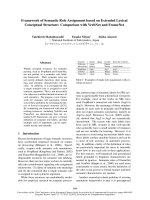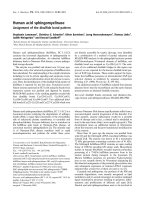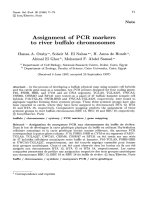MANAGERIAL ECONOMICS – BMME5103 ASSIGNMENT
Bạn đang xem bản rút gọn của tài liệu. Xem và tải ngay bản đầy đủ của tài liệu tại đây (701.92 KB, 15 trang )
ASSIGNMENT – BMME5103
SEMESTER 2014
MANAGERIAL ECONOMICS – BMME5103
ASSIGNMENT (60%)
Question 1
Assume you own and operate a small coffee shop located in a busy shopping complex. You
sell a range of hot and cold coffees, muffins and sandwiches.
a. Using the concepts of demand and supply substitutability, discuss and attempt to define
the market in which your business operates.(3 marks)
b. Product differentiation is seen to be an important part of your competitive strategy.
Explain what is meant by the term product differentiation, giving examples that could
apply to your market.
(3 marks)
c. Provide and explain two factors that will affect the demand and supply for the hot coffee.
Do these factors make a change in demand and supply? Give reasons for your answer.
(4 marks)
[TOTAL: 10 MARKS]
Answer:
a. Before my small coffee shop enters into the market, the market is equilibrium at the price
is P
0
and quatity is Q
0.
When I enter the market, the supply curve increase and shift to the right, the market now is
equilibrium at the new point: P
1
< P
0
and new quantity equilibrium is Q
1
> Q
0.
This result is
entirely consistent with the law of supply and demand: When you participate in the market, as
Pham Thi Hong Cuc Page 1
ASSIGNMENT – BMME5103
supply increases output if prices remain at the old, the buyer also purchased the old equilibrium
level of output, while this merchandise will be redundant, it was inevitable that you would have
to sell at lower prices than the original equilibrium price.
b. The term product differentiation:
One of strategies can help the company success in their business that is a differentiation, the
business can limit their competition as low as possible.Product differentiation is a marketing
strategy businesses use to gain an edge over their competitors. In industries where multiple
competitors produce similar products, managers will try to make their product unique in
some way so that it stands out from the pack. Sometimes this is done by pursuing a low-cost
strategy, and while that is a legitimate marketing strategy, it is different from product
differentiation. Product differentiation means that some feature, physical attribute, or
substantive difference exists between a product and all other possible alternatives.
c. Two factors that will affect the demand and supply for the hot coffee. They are price of
hot coffee and the price of substitute product is cool coffee.
- Price of hot coffee: Price makes increase the quatity of supply and decrease the quantity
of demand; and vice varsa.
- Price of substitute product: When the price of substitute product is increase to make the
demand of hot coffee increase, so the price of hot coffee also increases and quality of
demand also increase and vice versa.
Pham Thi Hong Cuc Page 2
ASSIGNMENT – BMME5103
Question 2
Suppose the same firm’s cost function is C(q) = 4q
2
+ 16.
a. Find variable cost, fixed cost, average cost, average variable cost, and average fixed cost.
(Hint: Marginal cost is given by MC = 8q).
(3 marks)
b. Show AC, MC, AVC on a graph.
(3 marks)
c. Find the output that minimizes AC.
(3 marks)
d. At what range of prices will the firm produce a positive output.
(2 marks)
e. At what range of prices will the firm earn a negative profit?
(2 marks)
f. At what range of prices will the firm earn a positive profit?
(2 marks)
[TOTAL: 15 MARKS]
Answer:
We have: C (q) = 4q
2
+ 16
a. Therefore, Variable cost is that part of total cost that depends on q (4q
2
) and fixed cost is
that part of total cost that does not depend on q (16).
VC = 4q
2
FC = 16
AC = TC/q = 4q + 16/q
AVC = VC/q = 4q
AFC = FC/q = 16/q
b. Show AC, MC, AVC, on a graph:
AC is u-shaped. Ac is relatively large at first because the firm is not able to spread the
fixed cost over very many units of output. As output increases, AFC will fall relatively
rapidle. AC will increase at some point because the AFC will become very small and
AVC is increasing as q increases. AVC will increase because of diminishing returns to
the variable factor labor. MC and AVC are linear, and both pass through the origin.
Pham Thi Hong Cuc Page 3
ASSIGNMENT – BMME5103
AVC is everywhere below AC. MC is everywhere above AVC. If the average is rising,
then the marginal must be above the average. MC will fit AC at its minimum point.
c. The output that minimizes average cost:
We have when MC = AC, the average cost will be minimum
AC = 4q + 16/q = 8q =MC
16/q = 4q
16 = 4 q
2
q
2
= 4 => q = 2.
d. The firm will produce a positive output at what range of prices:
The firm will supply positive levels of output as long as P = MC > AVC, or as long as t
firm is covering its variable costs of production. In this cse, MC is everywhere above
AVC so the firm will supply positive output at any positive price.
(P = MC => P = 4q + 16/q
With q = 2 => p = 16)
e. When the firm earn a negative profit:
The firm will earn negative profit when P = MC < AC, or at any price below minimum
average cost. In part d, we found that AC = 16. Therefore, the firm will earn negative
profit if P <16.
Pham Thi Hong Cuc Page 4
ASSIGNMENT – BMME5103
f. When the firm will earn a positive profit:
In part e, we found that the firm will earn negative profit at any price below 16 P<16.
Therefore, the firm will earns positive profit as long as P >16.
Question 3
Suppose you are given the following information about a particular industry:
Q
D
= 6500 – 100P Market demand
Q
S
= 1200P Market supply
C(q) = 722 + q
2
/200 Firm total cost function
MC(q) = 2q/200 Firm marginal cost function
Assume that all firms are identical and that the market is characterized by the pure
competition.
a. Find the equilibrium price, the equilibrium quantity, the output supplied by the firm, and
the profit of each firm.
(5 marks)
b. Would you expect to see entry into or exit from the industry in the long run? Explain.
What effect will entry or exit have on market equilibrium?
(5 marks)
c. What is the lowest price at which each firm would sell its output in the long run? Is profit
positive, negative, or zero at this price? Explain.
(3 marks)
d. What is the lowest price at which each firm would sell its output in the short run? Is profit
positive, negative, or zero at this price? Explain.
(2 marks)
[TOTAL: 15 MARKS]
Answer:
a. The equilirium price, quantity, output supplied by the firm and the profit of the firm:
The equilibrium when market supply equal to market demand.
We have: Q
D
= 6500 – 100P
Q
S
= 1200P
Q
D =
Q
S
6500 – 100P = 1200P
1100P = 6500
P = 5 => Q = 6000.
Pham Thi Hong Cuc Page 5
ASSIGNMENT – BMME5103
- To find the output for the firm, we set P = MC.
With P = 5
MC (q) = 2q/200
P = MC
2q/200 = 5
q = 500
- Profit of the firm is TR minus TC
π = TR – TC
π = pq – C (q) = 5 (500) – (722 +500
2
/200) = 528
Because the total output in the market Q = 6000, and the firm out put is q = 500, so 6000/500 =
12 firms in the industry.
b. Would you expect to see entry into or exist from the industry in the long run? Explain.
What effect will entry or exist have on market equilibrium?
In long run, when the market also bring profits to firms, entry will continues to P = MC = AC.
As firms enter the supply curve for industry will shift down and to the right and the equilibrium
price will fall, firms will be lost the fixed cost. Then, having firms can not stand anymore and
quit to the market.
c. What is the lowest price at which each firm would sell its output in the long run? Is profit
posititve, negative, or zero at this price? Explain.
In the long run, the firm will not sell for a price that is below minimum average cost. At any
price below minimum average cost, profit is negative and the firm is better off selling its fixed
resources and producing zero output. To find the minimum average cost, set MC = AC and solve
for q:
2q/ 200 = 722/q + q/200
q/200 = 722/ q
q
2
= 722 x 200
q = 380
AC (q) = 3.8
Therefore, the firm will not sell for any price less than 3.8 in the long run.
Pham Thi Hong Cuc Page 6
ASSIGNMENT – BMME5103
d. What is the lowest price at which each firm would sell its output in the short run? Is profit
postive, negative, or zero at this price? Explain.
The firm will sell for any positive price, because at any positive price marginal cost will be
above AVC (AVC = q/2000). Profit is negative as long as price is below minimum AC, or as
long as price is below 3.8.
Question 4
Suppose the demand and supply curves for good M are as follows:
QD = 70 - 2P
QS = -10 + 2P where P is price per kg measured in dollars and Q is quantity
measured in ‘000kgs
a. Sketch the demand and supply curves.
(2 marks)
b. Determine the equilibrium price and quantity.
(2 marks)
c. Calculate the value of the consumer and producer surplus at the equilibrium price.
(3 marks)
d. Explain why governments may introduce a price ceiling.
(3 marks)
e. Suppose a price ceiling of $15 were to be introduced. Calculate the consumer and
producer surplus after its introduction.
(3 marks)
f. Who has benefited from the introduction of the price ceiling?
(2 marks)
[TOTAL: 15 MARKS]
Answer:
a. Sketch the demand and supply curves:
We have: Q
D
= 70 – 2P
Q
S
= -10 + 2P
Pham Thi Hong Cuc Page 7
ASSIGNMENT – BMME5103
Supose P = 0 => Q
D
= 70, Q
S
= -10
Q
D
= 0 => P = 35
Q
S
= 0 => P = 5
Q
D
= Q
S
70 – 2P = -10 + 2P
4P = 80
P = 20; Q
D
= Q
S
= 30
b. The Equilibrium price and quantity:
Equilibrium price is 20$
Equilibrium quantity is 30,000 kgs
c. Consumer and producer surplus at the equilibrium price:
Consumer surplus = (35 - 20) x 30,000 x ½ = 225,000$
Producer surplus = (20 – 5) x 30,000 x ½ = 225,000$
d. Governments may introduce a price ceiling because:
- To keep the price down to an acceptable level
- During wartime price controls may be imposed on essential items such as: petrol, rice etc.
- To help the poor and the disadvantaged
e. Suppose P = $15 => the consumer and producer surplus:
P = 15$ => Q
S
= 20 ; Q
D
= 20 => P
D
= 25$
Consumer surplus = ½ x [ (35-15) + (25 -15) ] x 20,000 = 300,000$
Producer surplus = (15 -5) x 20,000 x ½ = 100,000 $
f. Because consumer surplus > producer surplus, consumer have benefit when introduce
ceiling price is $15.
Question 5
Firm 1 and firm 2 are automobile producers. Each has the option of producing either a big or a
small car. The payoffs to each of the four possible combinations of choices are as given the
Pham Thi Hong Cuc Page 8
ASSIGNMENT – BMME5103
following payoffs matrix. Each firm must make its choice without knowing what the other has
chosen.
Firm I
Big car Small car
Big car II
1
= 400 II
1
= 800
II
2
= 400 II
2
= 1000
Firm 2
Small car II
1
= 1000 II
1
= 500
II
2
= 800 II
2
= 500
a. Does either firm have a dominant strategy?
(2 marks)
b. There are two Nash equilibrium for this game. Identify them.
(3 marks)
[TOTAL: 5 MARKS]
Answer:
a. Does either firm have a dominant strategy?
A dominant strategy is the best response to the all strategies of all other players. In the
game above neither Firm 1 nor Firm 2 have a dominant strategy. In the table below the
underlined value are the choices that a _rm would make, given the other _rm has already
chosen the associated car size.
As can be seen in the table above, each firm would prefer to be producing the opposite
sized car as the other firm.
Pham Thi Hong Cuc Page 9
ASSIGNMENT – BMME5103
b. There are two Nash equilibrium for this game. Identify them.
In a two player game, a Nash Equilibrium is a strategy profile S
1
; S
2
such that, for each firm, S
1
is a best response to the other player’s equilibrium strategy S
2.
Again, looking at the underlined
choices above, we can see that this game has two pure strategies Nash Equilibrium, namely Firm
1 chooses big car, Firm 2 chooses small car and Firm 1 chooses small car, Firm 2 chooses big
car.
Addtitionally, since games almost always have an old number of Nash Equilibrium, we should
suspect that there is also mixed strategy equilibrium. We can find this equilidrium by calculating
the expected payoff for each firm. Let the strategies for each firm be given by (B; 1-B) and (b; 1-
b) for Firm 1 and Firm 2 respectively where B is the probability that Firm 1 chooses big car and
b is the probability that Firm 2 chooses big car. Then the expected payoff for Firm 1 can be
written as:
u
1
= B x b x 400 + B (1-b) 1000 + (1-B) (1-b) 500 + (1-B) b 800
= 500 + B 500 + b300 – B x b x 900
And the expected payoff for Firm 2 can be written as:
u
1
= B x b x 400 + B (1-b) 800 + (1-B) (1-b) 500 + (1-B) b 1000
= 500 + B 500 + b300 – B x b x 900
Then, we can use these result to _nd the
mixed equilibrium. If the second _rm is
playing the mixed strategy (b; 1-b), we can
find the utility of Firm1 on building a big
or small car respectively as:
u
1 ((big; (b; 1-b))
= 500 + 500 + b300 – b x 900
u
1 ((small; (b; 1-b))
= 500 + b 300
For this strategy to be in equilibrium these two
equations must be equal. Then, we find by
solving for b that b = 5/9. Now, we do the same for Firm 2.
u
2 ((big; (B; 1-B))
= 500 + 500 + B300 – B x 900
u
2 ((small; (B; 1-B))
= 500 + B 300
Pham Thi Hong Cuc Page 10
ASSIGNMENT – BMME5103
Again, setting these equal, we fin that B = 5/9. Then, our mixed Nash Equilibrium is that both
firms build big cars with probability 5/9. The following graph shows the three mixed equilibria,
two of which (E1 and E2) are the special cases of pure strategy equilibria.
Question 6
Two major networks are competing for viewer ratings in the 8:00 -9:00pm and 9:00-
10:00pm slots on a given weeknight. Each has two shows to fill this time period and is
juggling its lineup. Each can choose to put its “bigger” show first or to place it second in
the 9:00-10:00pm slot. The combination of decisions leads to the following “rating points”
results:
Network 1
Network 2
First Second
First 20, 30 18, 18
Second 15, 15 30, 10
a.Find the Nash equilibria for this game, assuming that both networks make their decisions at
the same time.
(4 marks)
b. If each network is risk - averse and uses a maximin strategy, what will be the resulting
equilibrium?
(4 marks)
c.What will be the equilibrium if Network 1 makes its selection first? If Network 2 goes
first?
(4 marks)
d. Suppose the network managers meet to coordinate schedules and Network 1 promises to
schedule its big show first. Is this promise credible? What would be the likely outcome?
(2 marks)
[TOTAL: 15 MARKS]
Answer:
a. The Nash equilibria for this game, assuming that both networks make their decisions at
the same time:
A Nash equilibria exists when neither party has an incentive to alter its strategy, taking the
other’s strategy as given. By inspecting each of the four combinations, we find that (Second,
First) is the only Nash equilibrium, yielding a payoff of (20, 30). There is no incentive for
Pham Thi Hong Cuc Page 11
ASSIGNMENT – BMME5103
either party to change from this outcome. If we pick First for Firm 1 and Second for Firm 2,
Firm 2 has an incentive to switch to First, in which case Firm 1 is better switching to Second.
b. If each network is risk – averse and uses a maximin strategy, what will be the resulting
equilibrium?
This conservative strategy of minimizing the maximum loss focuses on limiting the extent of
the worst possible outcome, to the exclusion of possible good outcomes. If Network 1 plays
First, the worst payoff is 15. If Network 2 plays First, the worst payoff is 15. If Network 2
plays Second, the worst payoff is 10. Under maximin, Network 2 plays First. The maximin
equilibrium is (Second, First) with a payoff of (20; 30). (This is a dominat strategy).
c. What will be the equilibrium if Network 1 makes its selection first? If Network 2 goes
first?
- If network 1 plays first, network 2 will also play first, yielding 15 for Network 1.
- If Network 1 plays Second, Network 2 will play first, yielding 20 for Network1.
Therefore, if it has the first move, Network 1 will play Second, and the resulting equilibrium will
be (Second, First).
- If Network 2 plays First, Network 1 will play Second, yielding 30 for Network 2.
- If Network 2 plays Second, Network 1 will play First, yielding 10 for Network 2.
If it has the first move, Network 2 will play First, and the euilibrium will be again (Second,
First).
d. Suppose the network managers meet to coordinate schedules and Network 1 promises to
schedule its big show first. Is this promise credible? What would be the likely outcome?
A move is credible if, one declared, there is no incentive to change. If Network 1 goes first, then
Network 2 will also want to go first which gives them both 15. In this case, once Network 1
knows that Network 2 also want to go first, Network 1 will wants to change its strategy to
Second. The promise in this case to schedule the bigger show first is not credible. Network 2 will
schedule its bigger show First since this is a dominat strategy and the coordinated outcome if
likely to be (Second, First).
Pham Thi Hong Cuc Page 12
ASSIGNMENT – BMME5103
Question 7
Bookworm and Easyread are both publishers of popular novels.
a. Assume that demand for Bookworm novels is elastic.
- Explain the meaning of the underlined term.
- Outline one important factor that you feel has helped to determine the size of this own
price elasticity.
- How would a fall in Bookworm’s price affect their total revenue?
(5 marks)
b. When the price of Easyread novels increased from $20 to $23, Bookworm’s sales
increased from 105,000 to 120,000 novels. Calculate the arc cross price elasticity. Are the
two brands of novels close substitutes? Explain.
(5 marks)
c. An increase in average weekly earnings from $290 to $310 caused Bookworm’s sales to
increase from 120,000 to 130,000 novels. Calculate and interpret the income elasticity.
(5 marks)
[TOTAL: 15 MARKS]
Answer:
a. - The meaning of elastic: Bookworn novels is elastic, it means when price of Bookworm
novels change, quantity demand will chang opposite bigger.
- One important factor that you feel has helped to determine the size of this own price
elasticity: It exist approximate products to substitute.
- Because demand of Bookworm novels is elastic, so the price decrease will make quantity
demand increase bigger. So total revenue will increase.
b. We have: Q
x1
= 120,000; Q
x2
= 105,000
P
y1
= 23; P
y2
= 20
E
xy
= ∆ Q
x
/ ∆ P
y
x (P
y1
+ P
y2
) / (Q
x1
+ Q
x2
)
= (120,000 – 105, 000) / (23 – 20) x (23 + 20) / (120,000 + 105,000)
= (15,000 x 43) / 3 x 225,000
= 0.96
Because E
xy
= 0.96 < 1, close to 1 so the two brands of novels are close subsitutes.
Pham Thi Hong Cuc Page 13
ASSIGNMENT – BMME5103
c. We have: Q
Y1
= 130,000; Q
Y2
= 120,000
Y
1
= 310; Y
2
= 290
E
Y
= ∆ Q
Y
/ ∆ Y
x (Y
1
+ Y
2
) / (Q
Y1
+ Q
Y2
)
= (130,000 – 120,000) / (310 – 290) x (310 + 290) / (130,000 + 120,000)
= (10,000 x 600) / (20 x 250, 000)
= 0.12
0 < E
Y
< 1: relatively inelastic.
Question 8
The following production function relates to a small firm that incurs fixed costs of $100
and labour costs of $10 per hour.
Labour Hours (L) Total Product (Q)
1 8
2 24
3 39
4 50
5 56
6 59
7 61
8 62
a. For each of the output levels shown above calculate:
• average and marginal product
• total variable and total cost
• average variable, average total and marginal cost
(6 marks)
b. For the above data, over which output range do we observe diminishing returns?
(4 marks)
[TOTAL: 10 MARKS]
Pham Thi Hong Cuc Page 14
ASSIGNMENT – BMME5103
Answer:
a. The output levels:
L Q AP=
Q/L
MP=
∆Q/∆L
TVC
=10*L
TC=
TVC +
TFC
AVC =
TVC/Q
ATC =
TC/Q
MC=
∆TVC/∆Q
1 8 8 8 10 110 1.25 13.75 1.25
2 24 12 16 20 120 0.83 5.00 0.63
3 39 13 15 30 130 0.77 3.33 0.67
4 50 12.50 11 40 140 0.80 2.80 0.91
5 56 11.20 6 50 150 0.89 2.68 1.67
6 59 9.83 3 60 160 1.02 2.71 3.33
7 61 8.71 2 70 170 1.15 2.79 5.00
8 62 7.75 1 80 180 1.29 2.90 10.00
b. For the above data, over which output range do we observe diminishing returns?
Over output range of 39 to 62, we observe diminishing returns
Pham Thi Hong Cuc Page 15
![Báo cáo khoa học: Assignment of the [4Fe-4S] clusters of Ech hydrogenase from Methanosarcina barkeri to individual subunits via the characterization of site-directed mutants pdf](https://media.store123doc.com/images/document/14/rc/do/medium_dor1394202044.jpg)
